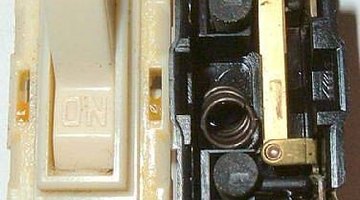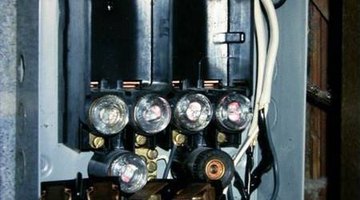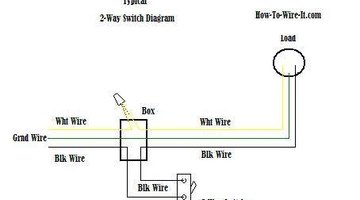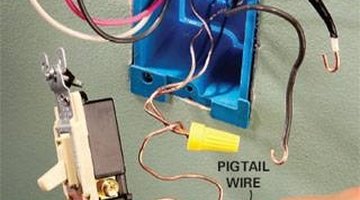How Does an Electrical Switch Work?
Electricity is an amazing and abundant power source. Its process takes place on a molecular level where atoms and electrons live. Currents form when electrons move in a flow. For electricity to flow through a household, the current has to travel through circuits. Circuits are made up of a power source and a load.

The Source

A load is the device that receives the power, like a lamp, or a television. The role of the electrical switch is to regulate the current that travels between the load and the power source. The power source is what pushes the electrons through the circuits. The amount of force or pressure applied by the power source is known as the voltage. Power sources must have a positive and a negative terminal. The negative terminal is wired to connect with the load, and drives the electrons through the circuit. The load receives the current, then sends it back to the power source through the positive terminal. The electrical switch is inserted within this loop.
Function

Electrical switches work according to a fairly basic design. The familiar on/off toggle switch is the most common. Three way circuits and dimmer circuits work off of a similar design. Three-way circuits are made up of two separate switches that control the same device(like a lamp); whereas a dimmer circuit merely regulates the amount of electricity that gets through. Electrical circuits only work when the electricity is free to move through in a continuous loop. Once that loop is broken, the electricity is cut off. This is where the switch comes in. An on/off toggle circuit breaks the current when it's in the "off" position. When it's in the "on" position, the current--or loop--is completed.
Components

The power source in a home is the fuse box. In order for an electrical switch to work it has to be connected to the fuse box and the load. A special type of cable called Romex is used to connect the power source to the switch, and to the electrical outlet that powers the load. Inside this insulated cable are three wires -a hot wire, a neutral wire, and a ground wire. The hot wire connects to one of the terminals on the switch, and to the outlet that powers the load. The neutral wire connects the other terminal to the load. The ground wire connects to the outlet. Electrical contacts inside the switch are what join the two terminals together. When a switch is turned on, these contacts are connected. When a switch is turned off, it causes a break between these contacts. In effect, the current is controlled by whatever position the switch is in.
The Drip Cap
- Electricity is an amazing and abundant power source.
- Electrical switches work according to a fairly basic design.
- When it's in the "on" position, the current--or loop--is completed.
- The hot wire connects to one of the terminals on the switch, and to the outlet that powers the load.
- The neutral wire connects the other terminal to the load.
- Electrical contacts inside the switch are what join the two terminals together.
- When a switch is turned on, these contacts are connected.
Resources
Writer Bio
Jacquelyn Jeanty has worked as a freelance writer since 2008. Her work appears at various websites. Her specialty areas include health, home and garden, Christianity and personal development. Jeanty holds a Bachelor of Arts in psychology from Purdue University.
Photo Credits
- http://www.rd.com/, http://i.ehow.com/, http://www.how-to-wire-it.com/, http://www.inspect-ny.com/
- http://www.rd.com/, http://i.ehow.com/, http://www.how-to-wire-it.com/, http://www.inspect-ny.com/
More Articles



